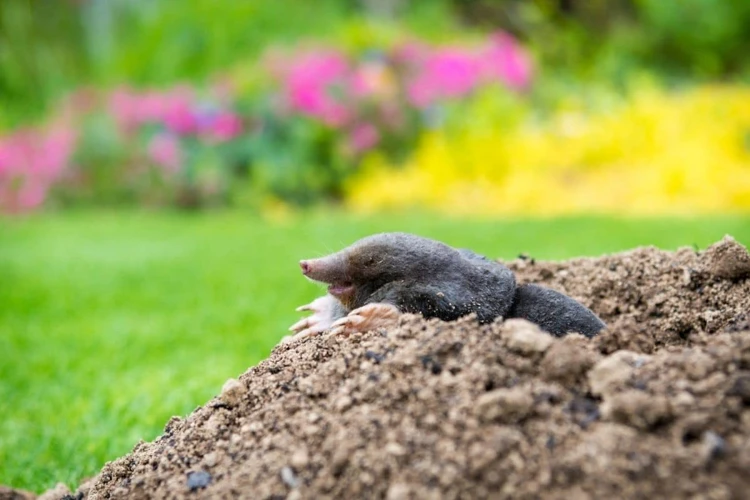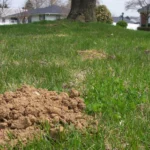Have you ever noticed unsightly tunnels or mounds of dirt in your garden or lawn? Have your plants or crops suffered damage from burrowing critters? If so, you may be dealing with a mole infestation. Moles are small mammals that have adapted to living underground, making them difficult to detect and manage. However, before resorting to harsh chemicals or traps, consider planting certain herbs that can help deter or repel moles. Not only will these plants help with mole prevention, but they can also improve soil quality and add visual interest to your landscaping. Keep reading to discover which herbs are best for mole prevention and how to plant them effectively.
Why are Moles a Problem?
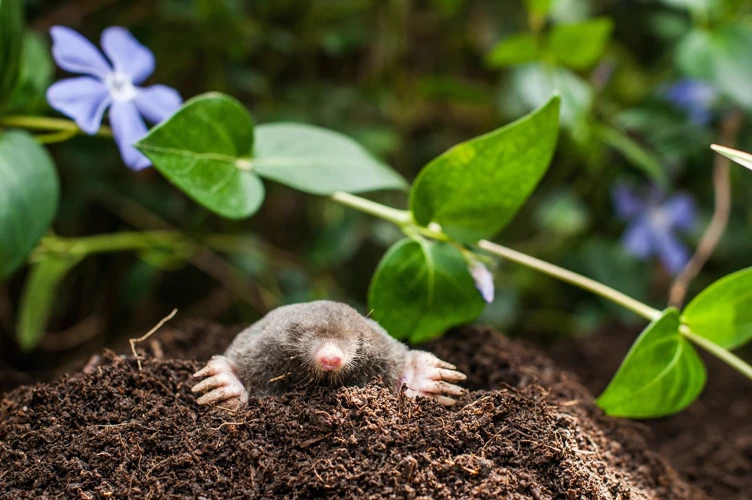
Moles are fascinating creatures, able to tunnel through soil at incredibly fast speeds. They’re small, but can cause big problems for gardeners and homeowners. Despite their usefulness in aerating soils and eating insects, moles can be detrimental to lawns and gardens when their digging activities cause unsightly and damaging lumps and ridges. It can be frustrating to try to get rid of them, and people are always looking for ways to control the problem. There are a variety of methods for preventing moles, including plant-based solutions, essential oils, and castor oil, but using certain herbs can also help keep moles at bay. In this section, we’ll explore why moles are a problem and how planting herbs can help prevent them.
Mole Damage
When moles make their way onto your property, they can cause significant damage. Their tunnels can uproot plants and destroy root systems, causing vegetation to weaken and die off. Moles also attract other unwanted pests, such as voles, which can further damage your lawn and garden.
The following table illustrates the common types of damage caused by moles:
| Type of Damage | Description |
|---|---|
| Mounds and ridges | As moles burrow through soil to create tunnels, they push up the dirt and sod above ground, forming mounds and ridges on the surface. These mounds can smother grass and create an uneven surface that makes mowing difficult. |
| Root damage | When moles burrow through soil, they often cut off or damage plant roots, which can stunt plant growth or cause plants to die. Certain plants are especially vulnerable to mole damage, such as those with shallow roots or bulbs that can be easily uprooted. |
| Soil erosion | Moles can cause soil erosion by burrowing through soil and destabilizing it. This can increase the risk of landslides and erosion, especially on sloped or uneven ground. |
| Molehills | As moles burrow through soil, they create molehills on the surface. These can make a lawn unsightly and difficult to maintain, and they can also attract other pests like voles or insects. |
To prevent this damage, it’s important to take steps to deter moles from your lawn and garden. One effective method is planting herbs that moles dislike. You can find more information about these herbs here.
Mole Prevention
Mole prevention is an important aspect of maintaining a healthy lawn or garden. While moles may seem harmless, their digging and burrowing can cause significant damage to the root systems of plants, which can result in stunted growth or even death. Additionally, their tunnels can create unsightly mounds that are difficult to mow or navigate around.
So, how can you prevent moles from wreaking havoc on your outdoor space? There are a few key steps you can take to deter these critters from taking up residence on your property.
- Remove their food source: Moles primarily feed on insects, grubs, and earthworms, so reducing the population of these creatures can help drive moles away. Removing any standing water, which can attract insects, can also be helpful.
- Eliminate potential shelter: Tall grass or weeds can provide moles with a place to hide, so regularly mowing and trimming your lawn can help discourage them from sticking around.
- Use physical barriers: Creating a barrier around your garden, such as a fence or raised bed, can make it more difficult for moles to access your plants. However, these barriers may not be foolproof, as moles are skilled at digging and tunneling.
- Plant specific herbs: Some herbs are known to have properties that can repel moles, while others can enhance soil quality, making it less appealing to these creatures. Planting a variety of herbs can help deter moles from entering your garden.
By following these steps and incorporating mole-repelling herbs into your garden, you can reduce the likelihood of these pests causing damage to your lawn or garden.
How Herbs Help Mole Prevention
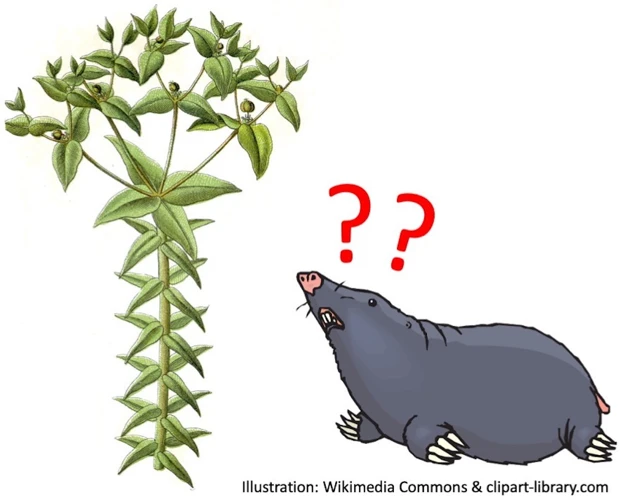
As we all know, moles can be a real problem in our gardens, causing damage to our plants and ruining the overall aesthetics of our outdoor space. However, there are natural ways to prevent moles from wreaking havoc in our gardens. One of the most effective and environmentally friendly methods is by using herbs. Herbs not only repel moles but also improve soil quality, making them an excellent option for mole prevention. Let’s explore how herbs can help deter moles and which ones are the most effective for this purpose.
Herbs That Repel Moles
Moles can be a nuisance in the garden, but planting certain herbs can help to repel these pesky creatures. Here are some herbs that repel moles:
- Marigolds: Not only do marigolds add a pop of color to your garden, but their strong aroma is detested by moles.
- Fritillarias: These plants contain a chemical compound that moles dislike, so planting them can help to keep moles away.
- Daffodils: Like fritillarias, moles are deterred by the scent of daffodils. Planting these bulbs can also add a lovely burst of yellow to your garden in the spring.
- Caper Spurge: This plant produces a sap that is toxic to moles and can cause skin irritation, which makes it an effective deterrent.
- Castor Beans: These plants contain a substance called ricin that is toxic to moles and other small animals, so planting them around the perimeter of your garden can help to keep moles at bay.
Keep in mind that while these herbs can help to repel moles, they may not work as a standalone solution. It’s important to implement other mole prevention strategies, such as controlling the moisture level of your soil and removing any food sources that may attract moles.
Herbs That Improve Soil Quality
There are several herbs that not only repel moles but also improve the quality of the soil, which can help to prevent moles from wreaking havoc in your garden. These herbs are:
- Comfrey: Comfrey is known for its ability to accumulate nutrients in its leaves. When its leaves decompose, the nutrients are released into the soil, improving its quality.
- Chamomile: Chamomile has natural antibacterial properties that can help to prevent soil-borne diseases.
- Yarrow: Yarrow has deep roots that can draw up nutrients and minerals from the soil, which can then be used by other plants in the area.
- Borage: Borage leaves can be used as a natural mulch, which will help to improve the soil’s moisture retention and prevent weeds from growing.
By planting these herbs in your garden, you will not only help to deter moles but also improve the overall health of your soil. This, in turn, will help to create a more hospitable environment for your plants to grow, making them less susceptible to damage caused by moles.
Best Herbs for Mole Prevention
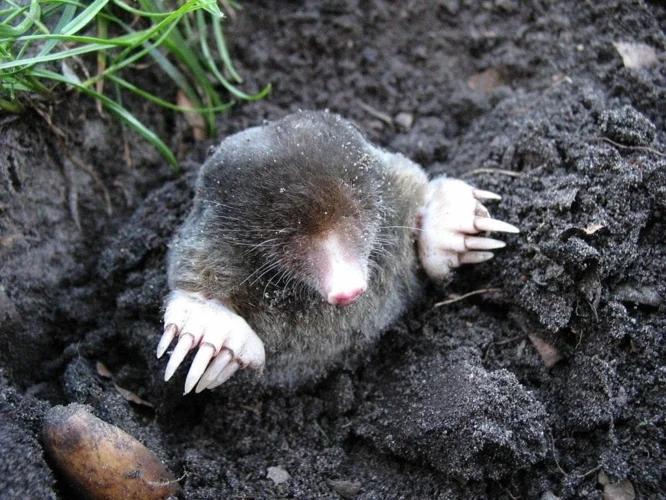
When it comes to preventing moles in your yard or garden, planting certain herbs can be an effective natural solution. These plant options can not only repel moles, but they can also improve soil quality, making them a double threat to mole infestations. Here are some of the top herbs to consider for your mole prevention plan.
1. Daffodils
Daffodils, also known as Narcissus, are a great herb for deterring moles from your garden. These beautiful and vibrant flowers contain galanthamine, a substance that is toxic to moles and other pests. The bright blooms can add a pop of color to your garden while keeping moles at bay.
When planting daffodils, it is important to plant them in the fall before the first frost. They prefer well-drained soil and an area that receives at least six hours of sunlight per day. Daffodils should be planted in clusters, with the bulbs buried about 6 inches deep and 6 inches apart. If you have a large garden, it is recommended to plant daffodils around the perimeter to create a barrier.
Tip: Avoid planting daffodils near plants that moles are attracted to, such as earthworms and grubs.
Daffodils also have the added benefit of being deer-resistant due to their toxic properties. They are a low-maintenance plant that will naturalize and come back year after year in the right conditions.
Caution: While daffodils are toxic to moles, they can also be toxic to humans and pets if ingested in large quantities. Be sure to wear gloves while handling daffodil bulbs and keep them out of reach of children and pets.
Planting daffodils is an effective and beautiful way to deter moles from your garden. By adding these vibrant flowers to your landscaping, you can enjoy a mole-free garden and a touch of spring all year round.
2. Alliums
Alliums are a family of herbs that include onions, garlic, chives, leeks, and shallots. They are known to have a strong scent that repels moles and other burrowing rodents. Alliums contain sulfur compounds which give them their distinct aroma, and this scent becomes even stronger when they are crushed or chopped.
Benefits of Alliums for Mole Prevention:
- Alliums are a natural and safe way to deter moles without harming them.
- The strong scent of alliums can keep moles and other burrowing rodents away from your garden.
- Alliums are easy to grow and can be used in a variety of dishes in the kitchen.
How to Plant Alliums for Mole Prevention:
- Plant alliums around the perimeter of your garden, or in the areas where you’ve noticed mole activity.
- Plant them in the fall, so they will have time to establish roots before winter.
- Plant them in well-draining soil in a sunny location.
- Space the bulbs about 6 inches apart, and plant them about 2 inches deep.
- Water them regularly until they become established.
Types of Alliums:
- Allium sativum – garlic
- Allium cepa – onion
- Allium schoenoprasum – chives
- Allium ampeloprasum – elephant garlic
Alliums are a great addition to any garden, not only for their pest-repelling properties but also for their culinary uses. By incorporating them into your garden, you can enjoy a beautiful and productive harvest, while also keeping moles at bay.
3. Fritillarias
Fritillarias are a great option for deterring moles as they produce an odor that moles find unappealing. These plants grow from bulbs and produce beautiful bell-shaped flowers in various colors, including purple, white, and yellow.
Here are some benefits of planting Fritillarias:
- They discourage moles from digging in your yard.
- They add an aesthetic appeal to your outdoor space with their charming blooms.
- They are relatively low maintenance plants that can be easily grown in most types of soil.
Fritillarias require well-draining soil and partial sun for optimal growth. When planting Fritillarias for mole prevention, it’s best to plant them in groups rather than scattering them all over the yard. This creates a stronger scent, which makes them more effective in deterring moles.
Here are some tips for planting Fritillarias:
- Plant the bulbs in the fall for spring blooms.
- Choose a location with partial to full sun exposure.
- Make sure the soil is well-draining and has adequate organic matter.
- Plant the bulbs 4-6 inches deep and space them 6-8 inches apart.
- Water them well after planting, and then maintain moderate moisture throughout the growing season.
In addition to their mole-repelling properties, Fritillarias also attract pollinators like bees and butterflies to your yard. However, it’s important to note that they may be toxic to pets and some humans if ingested, so it’s best to take precautionary measures when planting them in your outdoor space.
4. Castor Beans
Castor beans are another effective herb for preventing moles in your yard. The plant contains ricin, a toxic substance that repels not only moles but also other garden pests like voles and gophers. However, it’s important to handle castor beans with caution as ricin can be harmful to humans and pets if ingested.
Benefits
Aside from their mole-repelling properties, castor beans also improve soil quality. The plant’s large leaves and extensive root system work to break up heavy, compacted soil, allowing water and nutrients to penetrate more easily.
How to Plant
When planting castor beans, it’s recommended to wear gloves and long sleeves to protect your skin from the plant’s toxic sap. The seeds should be sown in well-draining soil and kept moist until they begin to sprout. Once established, the plants can grow up to 15 feet tall and should be spaced at least 3 feet apart.
Cautions
It’s important to note that the entire castor bean plant is toxic, not just the seeds. Contact with the plant’s leaves, stems, and roots can also cause skin irritation and other reactions. Keep children and pets away from the plant and dispose of any fallen leaves or seed pods promptly.
If used properly, castor beans can be a safe and effective way to deter moles and improve the overall health of your soil. However, if you have concerns about handling the plant, it’s best to choose another herb for mole prevention.
5. Euphorbias
One of the best plants for mole prevention is Euphorbia, which has a sort of “spurting” or “fountain-like” growth habit, with stiff stems that grow upwards and outwards. It has a distinctive appearance, with small leaves and a variety of striking colors ranging from yellow to purple.
The Benefits of Euphorbias for Mole Prevention:
– Euphorbias contain a toxic sap that repels moles and other pests. The sap can irritate the skin and eyes, so it’s important to handle them carefully with gloves.
– They thrive in sunlit areas and have a deep root system that improves soil quality by providing nutrients and breaking up dense clay soils.
– Euphorbias also produce a lot of foliage, which shades the ground and prevents weeds from growing. This makes for a less attractive environment for moles, who prefer areas with short, well-manicured grass.
How to Incorporate Euphorbias in Your Garden:
– Euphorbias are available as both shrubs and perennials, so you can choose the type that suits your landscaping needs best.
– Plant Euphorbias around the perimeter of your garden to create a barrier against moles.
– Alternatively, you can plant them in clusters or use them as a focal point in your garden to deter moles from digging.
– Euphorbias need well-draining soil and thrive in full sun, so make sure to plant them in an area that receives plenty of light and allows for proper drainage.
– Keep in mind that Euphorbias are toxic to humans and pets if ingested, so be sure to plant them in a safe location away from children and animals.
How to Plant Herbs to Deter Moles
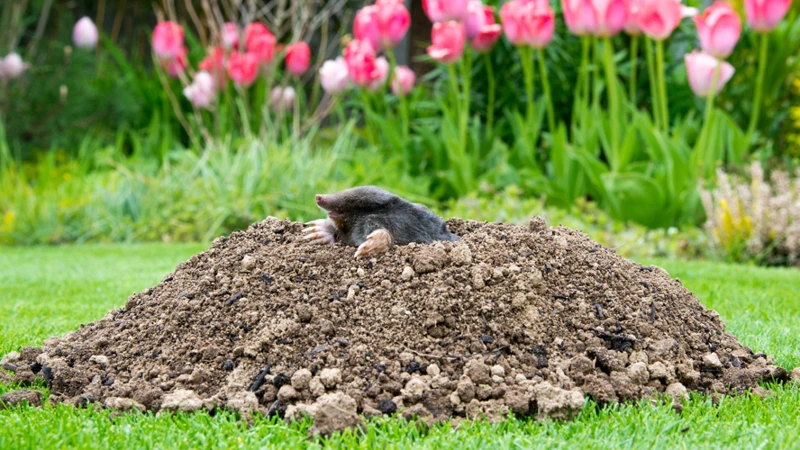
Planting herbs to deter moles is a natural and effective way to prevent mole infestation in your garden. Here are some tips on how to plant herbs for mole prevention:
1. Choose the Right Location: Choose a location that receives plenty of sunlight and is well-drained. Moles prefer damp soil and shade, so planting herbs in sunny, well-drained areas will deter them from burrowing in your garden.
2. Prepare the Soil: Before planting herbs for mole prevention, it is important to prepare the soil. Moles are attracted to loose, moist soil, so make sure to break up any compacted areas and add organic matter, such as compost or peat moss, to improve soil drainage.
3. Plant the Herbs: Once the soil is prepared, it is time to plant the herbs. Choose herbs that are known to deter moles, such as daffodils, alliums, fritillarias, castor beans, or euphorbias. Plant these herbs in areas where you have had mole activity before, around the perimeter of your garden, or throughout your garden beds.
4. Maintain the Herbs: After planting, it is important to maintain your herbs to ensure they continue to deter moles. Water the herbs regularly and keep the soil moist, but not too wet. Mulch around the herbs to help keep the soil moist and to deter weeds, which can attract moles.
5. Consider Companion Planting: Companion planting is a technique used to plant herbs or other plants together that have a mutual benefit. Consider planting marigolds or garlic alongside your herbs for added mole prevention. Marigolds have a strong scent that moles do not like, while garlic emits odors that repel moles.
By following these steps, you can plant herbs to naturally deter moles from your garden. Remember, it may take some trial and error to figure out which herbs work best for your garden and mole prevention needs.
Additional Tips for Mole Prevention
Preventing moles from damaging your garden and lawn requires persistence and a multi-faceted approach. Planting certain herbs can certainly help, but there are several other measures you can take to effectively prevent mole damage.
1. Remove their food source: Moles primarily feed on earthworms, grubs, and other insects, so reducing their food source can make your garden and lawn less attractive to them. You can do this by using insecticides to eliminate grubs and other insects that moles feed on.
2. Water your plants deeply: Watering your plants deeply encourages earthworms to come to the surface. This can make it easier for moles to catch their prey, but soapy water or earthworm control pellets can eliminate their source of food.
3. Use barriers: Placing barriers around your garden or lawn can help prevent moles from burrowing into the area. You can use hardware cloth or wire mesh to create an underground barrier. This prevents moles from burrowing under your lawn and garden.
4. Clear away debris: Removing debris from your garden and lawn can reduce the number of hiding places for moles. This can include piles of leaves or grass clippings, firewood stacks, or other areas that provide cover for moles.
5. Create vibrations: Moles are sensitive to vibrations, so creating constant noise or vibrations in your garden or lawn can discourage them from taking up residence. This can include using wind chimes, playing music, or even using a vibrating mole repellent.
6. Set traps: Setting traps can help capture moles that have already burrowed into your garden or lawn. You can use humane traps that capture the mole alive, which can then be relocated to a different area away from your garden and lawn.
By taking these additional steps along with planting certain herbs that repel moles, you can create a fully round mole prevention plan for your garden and lawn. Be patient, persistent, and try different methods to determine what works best for you.
Conclusion
In conclusion, planting certain herbs can be an effective and natural way to prevent mole damage in your garden. By using herbs to repel moles and improve soil quality, you can create an environment that is less appealing to moles and encourages healthier plant growth.
The best herbs for mole prevention include daffodils, alliums, fritillarias, castor beans, and euphorbias. These plants not only repel moles with their pungent scent but also improve soil quality with their nutrient-rich properties.
When planting these herbs, it’s essential to place them strategically throughout your garden, focusing on areas that are prone to mole activity. By doing so, you can create a barrier that moles will find unappealing and help prevent them from causing damage to your plants.
Along with planting herbs, there are additional tips for mole prevention, including keeping your lawn well-maintained, removing excess thatch and debris, and using humane traps if moles do become a problem.
Overall, mole prevention doesn’t have to be a complicated or expensive process. By incorporating the right herbs and following a few simple tips, you can create a beautiful and mole-free garden that you can enjoy all season long.
Frequently Asked Questions
How can I tell if I have a mole problem?
If you notice a series of ridges or mounds in your lawn, garden, or field, it’s likely that moles are present underground.
Why do moles dig tunnels?
Moles create tunnels in search of food, such as earthworms and grubs, and to create burrows for nesting and protection.
Do moles cause damage to plants?
While moles don’t feed on plants directly, they can uproot or displace plants while tunneling, and their tunnels can weaken roots and cause damage.
What can I do to prevent moles from entering my garden?
One way to prevent moles from entering your garden is by planting certain herbs that repel them or improve soil quality, as discussed in this article.
Are there any natural remedies for getting rid of moles?
Some natural remedies for getting rid of moles include using repellents like castor oil or garlic, or setting traps. However, it’s important to use these methods carefully to avoid harming other wildlife or pets.
Can I use chemical pesticides to get rid of moles?
While chemical pesticides can be effective against moles, they can also harm other wildlife and pollute the environment. It’s always best to use natural or non-toxic methods first.
How often should I water the herbs that repel moles?
The watering needs of herbs that repel moles will depend on the specific plant and the climate in your area. Generally, watering deeply once or twice a week should be sufficient.
Can I plant herbs for mole prevention in containers?
Yes, you can plant herbs for mole prevention in containers. Using raised beds or planting in containers can also help prevent moles from tunneling into your garden.
What is the best time of year to plant herbs for mole prevention?
The best time to plant herbs for mole prevention will depend on the specific plant and the climate in your area. In general, it’s best to plant in the spring or fall.
Are there any herbs that attract moles?
No, there are not any herbs that are known to attract moles. However, planting certain types of vegetation, such as dense grass or some types of bushes, may provide moles with a habitat that makes them more likely to be present in your yard.

